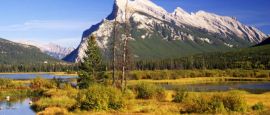Travel to Canada
Flying to Canada
Air Canada (www.aircanada.com) is the country’s flag carrier airline and currently operate routes between Canada and more than 80 international destinations.
Airlines flying from the UK to Canada also include British Airways (www.ba.com), Air Transat (www.airtransat.co.uk) and WestJet (www.westjet.com). Most major US carriers fly from the USA.
Major airports are: Calgary International Airport, Vancouver International Airport, Halifax Stanfield International Airport, Ottawa International Airport, Toronto Pearson International Airport, Montreal Pierre Elliott Trudeau International Airport, Edmonton International Airport and Winnipeg International Airport.
From London: to Calgary - 8 hours 50 minutes; to Halifax - 7 hours 5 minutes; to Montreal - 7 hours 10 minutes; to Toronto - 7 hours 45 minutes; to Vancouver - 9 hours 30 minutes.
From New York: to Calgary - 5 hours 25 minutes; to Halifax - 1 hour 50 minutes; to Montreal - 1 hour 35 minutes; to Toronto - 1 hour 30 minutes; to Vancouver - 5 hours 45 minutes.
Star Alliance Round the World: Allows travel to hundreds of destinations within more than 190 countries including Canada. Full details are available from roundtheworld.staralliance.com/.
Airport guides
Airport Code: YYC. Location: Calgary International Airport is located 17km (10.5 miles) northeast of Calgary. Money: ATMs and bureau de change are located on all levels of the terminal building, both in Arrivals and... Read more
Airport Code: YHZ. Location: Halifax Stanfield International Airport is situated 35km (22 miles) north of central Halifax. Money: Bureau de change and travel insurance facilities are available at the International Currency... Read more
Airport Code: YUL. Location: Montréal-Pierre Elliott Trudeau International Airport is located 20km (12 miles) west of Montréal. Money: ATMs and bureaux de change are positioned throughout the terminal, including one that dispenses... Read more
Airport Code: YYZ. Location: Toronto Pearson International Airport is located 27km (17 miles) northwest of Toronto city centre. Money: Bureaux de change, banks and ATMs are available throughout both terminals. Read more
Airport Code: YVR. Location: Vancouver International Airport is located 13km (8 miles) south of Vancouver city centre. The... Money: ATMs are available. ICE Currency Exchange has ten counters located before and after security, in... Read more
Airport Code: YOW. Location: Ottawa International Airport is located 10km (6 miles) south of central Ottawa. Money: ATMs can be found on all levels of the terminal building, and bureaux de change kiosks are located... Read more
Travel by rail
The Canadian rail system connects to the USA at several points. US rail operator Amtrak (tel: +1 800 872 7245; www.amtrak.com) runs the following international routes: New York-Albany-Saratoga Springs-Montreal (the Adirondack), New York-Syracuse-Rochester-Buffalo-Niagara Falls-Toronto (the Maple Leaf) and Eugene-Portland-Tacoma-Seattle-Vancouver (the Amtrak Cascades).
The Rocky Mountaineer train (tel: +1 604 606 7245; www.rockymountaineer.com) also runs the 'Coastal Passage' tourist route from Seattle to the Canadian Rockies, via Vancouver.
There are no international rail passes covering trains into Canada. Amtrak’s USA Rail Pass does not include routes north of the US border.
Be aware that trains can be subject to delays at US/Canada border crossings.
Driving to Canada
The only road access to Canada is through the southern border with the USA or from the west through Alaska. There are numerous road crossings between the two countries.
Greyhound (tel: +1 800 661 8747; www.greyhound.ca) runs several coaches between the USA and Canada. Routes include New York to Montreal, Detroit to Toronto/Hamilton, and Seattle to Vancouver. Note there is no coach service at all between the two countries west of South Eastern Ontario until you reach Vancouver.
Getting to Canada by boat
Canada has many ports served by international shipping lines. Montreal (www.port-montreal.com) is a popular port for cruise ships. The port of Vancouver (www.portmetrovancouver.com), one of Canada's busiest ports, is on the west coast and is a common start point for cruise ships travelling to Alaska. Toronto's port (www.portstoronto.com) is on the North Western shore of Lake Ontario.
Halifax, Nova Scotia (www.portofhalifax.ca), Saint John, New Brunswick (www.sjport.com) and St John's, Newfoundland (www.sjpa.com) are some of the principal ports on the Atlantic coast.
Vancouver is heaving with cruise passengers during the spring and summer months, as hordes of tourists board ships heading north to Alaska. Sailing through the stunning Inside Passage, the itinerary takes in dramatic fjords, mountains and a bounty of wildlife; numerous cruise lines compete for business on this popular route. Montreal is a starting point for trips along the St Lawrence River as well as a stop on longer cruises around eastern Canada and New England.
The Victoria Clipper (tel: +1 800 888 2535; www.clippervacations.com/ferry) runs from Seattle, Washington, USA to Victoria, British Columbia, while BlackBall Ferry Line (tel: +1 250 386 2202; www.cohoferry.com) connects Port Angeles, Washington with Victoria.
Alaska Marine Highway System (tel: +1 800 264 6475; www.dot.state.ak.us/amhs) runs ferries between several Alaskan ports and Prince Rupert, British Columbia.
Do you have any Feedback about this page?
© 2026 Columbus Travel Media Ltd. All rights reserved. No part of this site may be reproduced without our written permission, click here for information on Columbus Content Solutions.





 You know where
You know where
